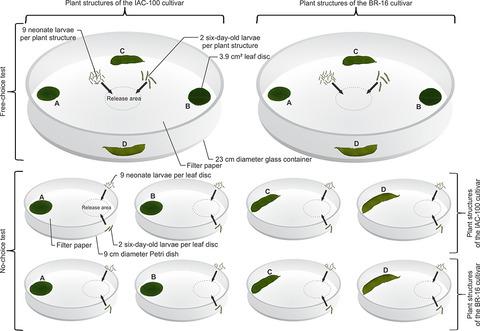当前位置:
X-MOL 学术
›
Entomol. Exp. Appl.
›
论文详情
Our official English website, www.x-mol.net, welcomes your
feedback! (Note: you will need to create a separate account there.)
Protocol for assessing soybean antixenosis to Heliothis virescens
Entomologia Experimentalis et Applicata ( IF 1.4 ) Pub Date : 2020-12-01 , DOI: 10.1111/eea.12997 Wellington Ivo Eduardo 1 , Arlindo Leal Boiça Júnior 1 , Renato Franco Oliveira Moraes 1 , Bruno Henrique Sardinha Souza 2 , Helder Louvandini 3 , José Carlos Barbosa 1
Entomologia Experimentalis et Applicata ( IF 1.4 ) Pub Date : 2020-12-01 , DOI: 10.1111/eea.12997 Wellington Ivo Eduardo 1 , Arlindo Leal Boiça Júnior 1 , Renato Franco Oliveira Moraes 1 , Bruno Henrique Sardinha Souza 2 , Helder Louvandini 3 , José Carlos Barbosa 1
Affiliation

|
Larvae of Heliothis virescens (Fabricius) (Lepidoptera: Noctuidae) often infest soybean crops, Glycine max (L.) (Fabaceae), causing significant yield losses in important soybean‐producing regions. The use of soybean varieties resistant to lepidopteran larvae is a major approach in soybean integrated pest management. However, standardization and optimization of bioassays that are used to screen genotypes for insect resistance are essential for high‐throughput phenotyping. Methodologies for screening were assessed to determine the most effective method for discriminating levels of antixenosis to H. virescens in soybean plants. Feeding and oviposition preference assays were performed to determine optimal densities of larvae and adults, and optimal plant structures and growth stages for conducting assays. In addition, trichome densities, and fiber and lignin contents were quantified in plant structures of soybean cultivars differing in resistance. Resistance levels of cultivars were best differentiated using nine neonate larvae and two 6‐day‐old larvae, and by using young leaves of plants at the vegetative stage. This was likely due to the more pronounced differences in lignin and fiber contents in young leaves of vegetative‐stage plants. Density of adult pairs, plant structure, and growth stage did not affect ability to distinguish differences in oviposition preference by H. virescens. Higher numbers of eggs were found on the leaves, which were the plant structures that exhibited the lowest trichome densities. The protocol developed in this work will benefit future evaluations of soybean genotypes for antixenosis against H. virescens.
中文翻译:

评估大豆对紫日夜蛾抗毒作用的方案
Heliothis virescens (Fabricius) (Lepidoptera: Noctuidae) 的幼虫经常侵染大豆作物 Glycine max (L.) (Fabaceae),在重要的大豆产区造成显着的产量损失。使用抗鳞翅目幼虫的大豆品种是大豆病虫害综合治理的主要方法。然而,用于筛选昆虫抗性基因型的生物测定的标准化和优化对于高通量表型分析至关重要。对筛选方法进行了评估,以确定区分大豆植物中对 H. virescens 的抗排毒水平的最有效方法。进行喂养和产卵偏好测定以确定幼虫和成虫的最佳密度,以及进行测定的最佳植物结构和生长阶段。此外,毛状体密度,在不同抗性的大豆品种的植物结构中量化纤维和木质素含量。使用 9 只新生幼虫和 2 只 6 日龄幼虫,并使用处于营养阶段的植物幼叶,可以最好地区分栽培品种的抗性水平。这可能是由于营养阶段植物幼叶中木质素和纤维含量的更显着差异所致。成虫对的密度、植物结构和生长阶段不影响 H. virescens 区分产卵偏好差异的能力。在叶子上发现了更多的卵,这是表现出最低毛状体密度的植物结构。在这项工作中开发的协议将有利于未来对大豆基因型对 H. virescens 进行抗毒的评估。
更新日期:2020-12-01
中文翻译:

评估大豆对紫日夜蛾抗毒作用的方案
Heliothis virescens (Fabricius) (Lepidoptera: Noctuidae) 的幼虫经常侵染大豆作物 Glycine max (L.) (Fabaceae),在重要的大豆产区造成显着的产量损失。使用抗鳞翅目幼虫的大豆品种是大豆病虫害综合治理的主要方法。然而,用于筛选昆虫抗性基因型的生物测定的标准化和优化对于高通量表型分析至关重要。对筛选方法进行了评估,以确定区分大豆植物中对 H. virescens 的抗排毒水平的最有效方法。进行喂养和产卵偏好测定以确定幼虫和成虫的最佳密度,以及进行测定的最佳植物结构和生长阶段。此外,毛状体密度,在不同抗性的大豆品种的植物结构中量化纤维和木质素含量。使用 9 只新生幼虫和 2 只 6 日龄幼虫,并使用处于营养阶段的植物幼叶,可以最好地区分栽培品种的抗性水平。这可能是由于营养阶段植物幼叶中木质素和纤维含量的更显着差异所致。成虫对的密度、植物结构和生长阶段不影响 H. virescens 区分产卵偏好差异的能力。在叶子上发现了更多的卵,这是表现出最低毛状体密度的植物结构。在这项工作中开发的协议将有利于未来对大豆基因型对 H. virescens 进行抗毒的评估。










































 京公网安备 11010802027423号
京公网安备 11010802027423号